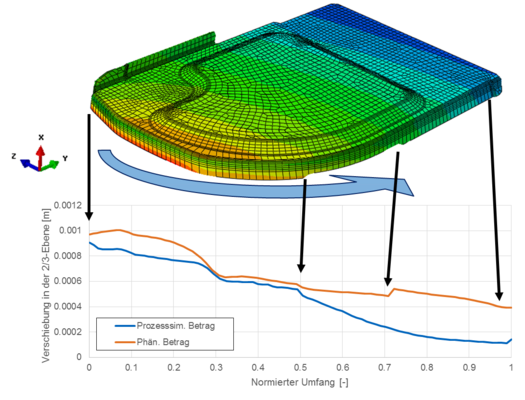MAI TAI – Tools for Accelerated Industrialization
Innovative tools for an efficient industrialization of CFRP parts
Project Partners
Airbus Helicopters GmbH, BMW AG
Duration
01.12.2014 – 31.05.2017
Funding authority
German Federal Ministry of Education and Research
Motivation
The goal of the project MAI TAI was to shorten the industrialization phase of the production of carbon fiber reinforced plastics (CFRP) by means of new tooling technologies. The risks lay in technical problems that led to high amounts of scrap material, expensive rework of the forming tools and of the process itself as well as ultimately occuring delays. Thus, a cutting-edge sequence for design and industrialization of the production of CFRP had to be developed, an economic analysis had to be conducted and the possibility of a later serial production had to be investigated in the project MAI TAI.

Method
For determining the potential for optimization of the modelling techniques of the CAD->CAE interface, a process simulation model was developed for the CAD model of the MAI TAI demonstrator part. The necessary steps were checked for automation capacity. It was shown, that a high degree of automatization in developing a simulation model cannot be reached with parts of such high degree of complexity as the MAI TAI demonstrator. With the aim of developing a strategy for an accelerated process simulation, the findings were summarized to “best practise“ guidelines for modelling work. By means of these guidelines, the demonstrator part was investigated in four different levels of discretization. The four levels of discretization for the calculation of the demonstrator were distributed between Airbus Helicopters and TUM-LCC. Whereas Airbus Helicopters implemented simplifications of the simulation model and the underlying material laws based on their available data, TUM-LCC delivered the numerical reference by a complete process simulation. In this process simulation, material models that are dependent on time, degree of cure and temperature in combination with a layerwise modelling of the component were applied. At the same time, a second simulation model of the same level of discretization but reduced material modelling accuracy was developed. This was carried out in order to compare the complete process simulation with a phenomenological simulation. A comparison with data of the gauged part showed that both simulation strategies made right predictions regarding process induced deformations on a qualitative basis. In a quantitative basis, both simulation strategies differ from each other to a considerable extent. This could, in this case, be traced to a high degree of tool part interaction, which can only be accounted for in the complete process simulation. With the results regarding an accelerated process simulation, the influence of the design features sandwich core and gusset filler on process induced deformatios were examined. Whereas Airbus Helicopters investigated the gusset filler, TUM-LCC studied the relevance of classical spring-in at the sandwich by means of phenomenological simulation, complete process simulation and analytical considerations. It was found out that the influence of the sandwich regarding spring-in is negligible at similar bending stiffnesses of the laminates as long as the upper laminate is not significantly thicker than the lower laminate.
Publications
Lipcan, M.; Balvers, J.M.; Hartmann, M.P.: Thermal response of frame-like composite structures to analytically assess manufacturing distortion. Composites Part A: Applied Science and Manufacturing 107, 2018, 399-408
Lipcan, M.; Balvers, J.M.: Pre-Assessment of distortion in frame-like composite structures for Industrial application. ECCM17 - 17th European Conference on Composite Materials, 2016
Acknowledgement
The chair thankfully acknowledges the funding of the project “Tools for Accelerated Industrialization – MAI TAI” provided by the German Federal Ministry of Education and Research under the leading-edge cluster MAI Carbon (funding code: 03MAI26D).



Contact Persons
Dr.-Ing. Swen Zaremba
Final Report
External link (pdf)